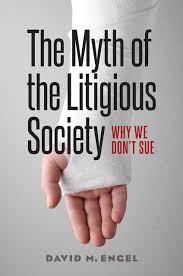In The Myth of the Litigious Society: Why We Don’t Sue, David M. Engel challenges the assumption that the USA is a compensation culture, instead showing that victims of injuries usually do not seek meaningful redress. Although the book’s central claim would be strengthened by evidence from more recent studies than those presented in the text, M. Bob Kao finds this a convincing argument in favour of shifting a hitherto dominant narrative to the potential benefit of victims of injury who may otherwise forego their claims.
The Myth of the Litigious Society: Why We Don’t Sue. David M. Engel. University of Chicago Press. 2016.
 As I was writing this book review, I came across a popular online forum on which a US user sought legal advice regarding her father’s death due to injuries sustained from a fall while shopping at a store. She enquired whether her family could request the store pay for the funeral expenses. Based on the limited facts supplied, the case appeared to be a slam dunk for substantially more compensation than the user realised due to the store’s negligence. The poster did not speak to a lawyer before seeking assistance online because she was afraid of the costs; she was unaware that these types of cases are typically accepted on a contingency basis – meaning the lawyer will only get paid if she wins. In a subsequent post, she stated that she had talked to a personal injury lawyer at the urging of other users and may pursue litigation.
As I was writing this book review, I came across a popular online forum on which a US user sought legal advice regarding her father’s death due to injuries sustained from a fall while shopping at a store. She enquired whether her family could request the store pay for the funeral expenses. Based on the limited facts supplied, the case appeared to be a slam dunk for substantially more compensation than the user realised due to the store’s negligence. The poster did not speak to a lawyer before seeking assistance online because she was afraid of the costs; she was unaware that these types of cases are typically accepted on a contingency basis – meaning the lawyer will only get paid if she wins. In a subsequent post, she stated that she had talked to a personal injury lawyer at the urging of other users and may pursue litigation.
Had she not posted her message, she may very well have committed ‘lumping’. In The Myth of the Litigious Society: Why We Don’t Sue, David M. Engel defines lumping as instances where the victim does not take action to seek compensation from the wrongdoer. Lumping, according to Engel, is not merely refraining from filing lawsuits, but also ‘not confronting the injurer in any significant way to seek redress’ to instead ‘rely on whatever resource – financial, psychological, and spiritual – they can muster on their own’ (21).
Contrary to popular belief, people do not usually sue when they are injured. The oft-repeated narrative that personal injury lawsuits and the damages awarded by juries in the United States are out of control is simply not supported by evidence. The cases reported in the media and used by tort reform advocates to justify limiting people’s access to civil justice are either outliers or framed in ways that distort the facts and legal reasoning. This myth is so pervasive and durable that many law students and lawyers also buy into it because of the nature of legal education where, for the most part, only legal opinions – situations in which the victim has already sued – are studied. In reality, the vast majority of people – nine out of ten in the United States according to studies cited in the book – forego their claims.

Engel thus asks not why the USA is such a litigious society, because that is the wrong question; rather, he explores the reasons why victims of injuries do not seek compensation. He examines the experiences of people harmed by others and offers eight main reasons for lumping. First, suffering may ‘create a sense of existential change and identity confusion’ (172) and affect the victim’s decision-making. Second, society holds a negative view of those who seek compensation, stereotyping them as greedy and deceitful. Third, the victim’s cognitive abilities may be biased by the injury, leading to irrational thinking. Fourth, as injury is a cultural construct, what may be compensable is not seen as an injury due to cultural framing. Fifth, dangerous situations leading to injury are perceived to be part of the natural environment and inevitable, so the victim may blame their own carelessness instead of external factors. Sixth, deliberate choices made by manufacturers and service providers are seen as unavoidable and thus the blame is again placed on the user. Seventh, causation is a cultural and social concept, and victims may not make the link between the actions of the injurer and the injury. Eighth, ‘friends and relatives tend to reflect the societal consensus that it’s bad to claim, and the victim who demands compensation will become a social pariah’ (175).
Ultimately, Engel seeks to ‘find another voice that is more true to the experiences of injury victims’ (189), so that policy debates can focus on meaningful redress for victims. Currently, the existence of a significant amount of lumping leads to three negative consequences for victims and the society. First, the aims of tort law – compensating victims, deterring injurers, redistributing losses and enacting moral justice – cannot be adequately fulfilled. Second, the signalling function of tort law, which brings new sources of harm to the attention of government regulators and frames the cultural construction of injuries, cannot be met. Finally, injury victims who cannot be adequately compensated under the current system and their social networks bear the brunt of the costs – monetarily, professionally, socially and psychologically – instead of the responsible wrongdoer. Though Engel offers existing work-arounds, he argues that a cultural change is necessary to fundamentally address the problem. A ‘more balanced, humane, nuanced, and respectful framework for understanding injuries, injurers, and injury victims’ must replace the unsympathetic view of victims and their lawyers so the goals that tort law purports to address but has failed in practice can be fulfilled (190).
Engel presents a convincing argument for a shifting of the dominant narrative based on evidence of the insufficiency of the civil justice system and social science studies that explain why human nature and societal forces have led to the current predicament. Although transforming the system requires public policy debates, widespread acceptance and investment in public relations, as Engel proposes, there is no reason that personal injury lawyers on the frontline, social workers and television writers cannot actively do their part by injecting this perspective into their daily work to transform the narrative through everyday forms of resistance.
One minor criticism of this book is that the basis of Engel’s claim that victims lump are all decades-old studies. While lumping inevitably still exists today, it may be worth questioning whether the rate holds true. The world has changed at a more rapid pace in the last decade with the widespread use of the internet. The way people connect, communicate and share information has revolutionised. A decade ago, the aforementioned poster may have simply buried her father without asking the store for compensation. She may never have approached a lawyer due to her assumption that it would be too costly. There may not have been an appropriate and easily accessible online community. While social scientists and law and society scholars should investigate whether the frequency of lumping is negatively correlated with the rise of technological advances, ultimately the results of such studies, whatever they are, should not diminish the general thrust of Engel’s thesis and its import.
This review originally appeared at the LSE Review of Books.
Please read our comments policy before commenting.
Note: This article gives the views of the authors, and not the position of USAPP– American Politics and Policy, nor of the London School of Economics.
Shortened URL for this post: http://bit.ly/2lwTOyC
——————————————–
M. Bob Kao – Queen Mary, University of London
M. Bob Kao is a PhD candidate at the Centre for Commercial Law Studies, Queen Mary, University of London. He was a public interest lawyer in California and has taught American law in Taiwan and China. Read more reviews by M. Bob Kao.






